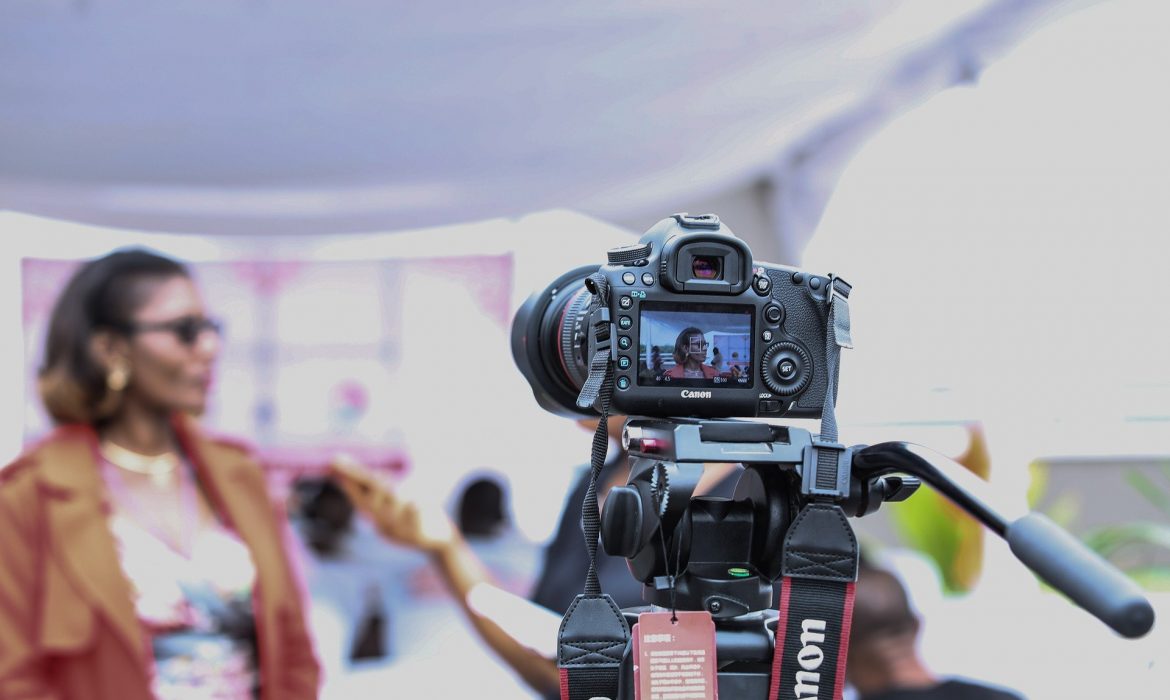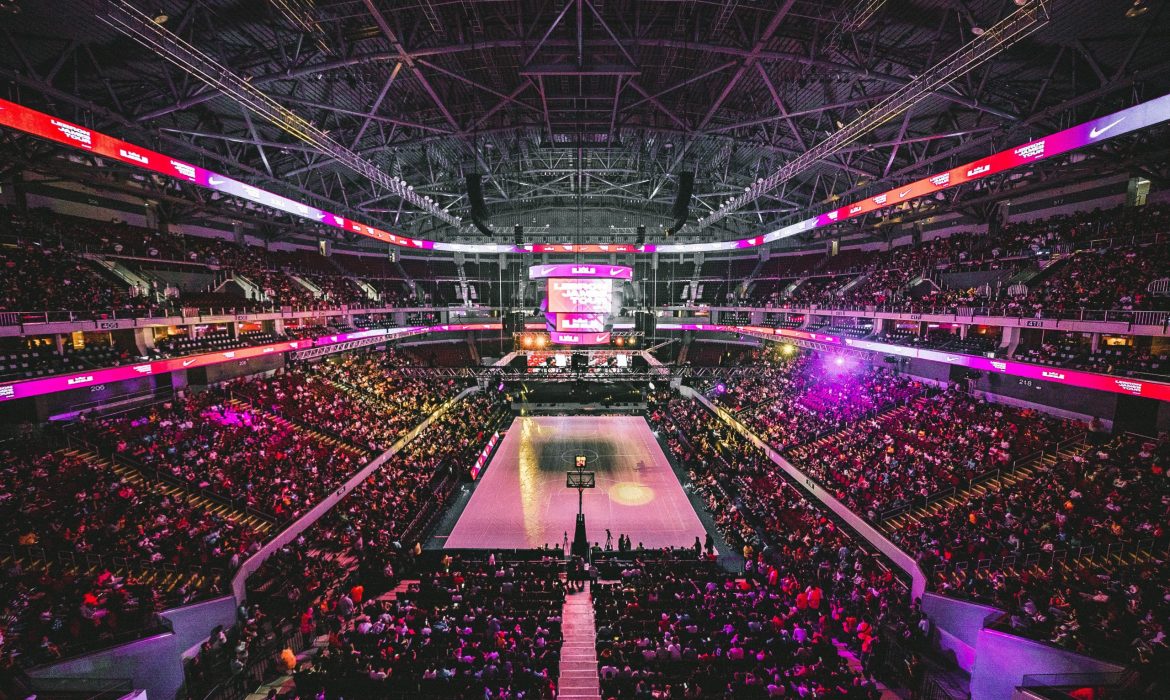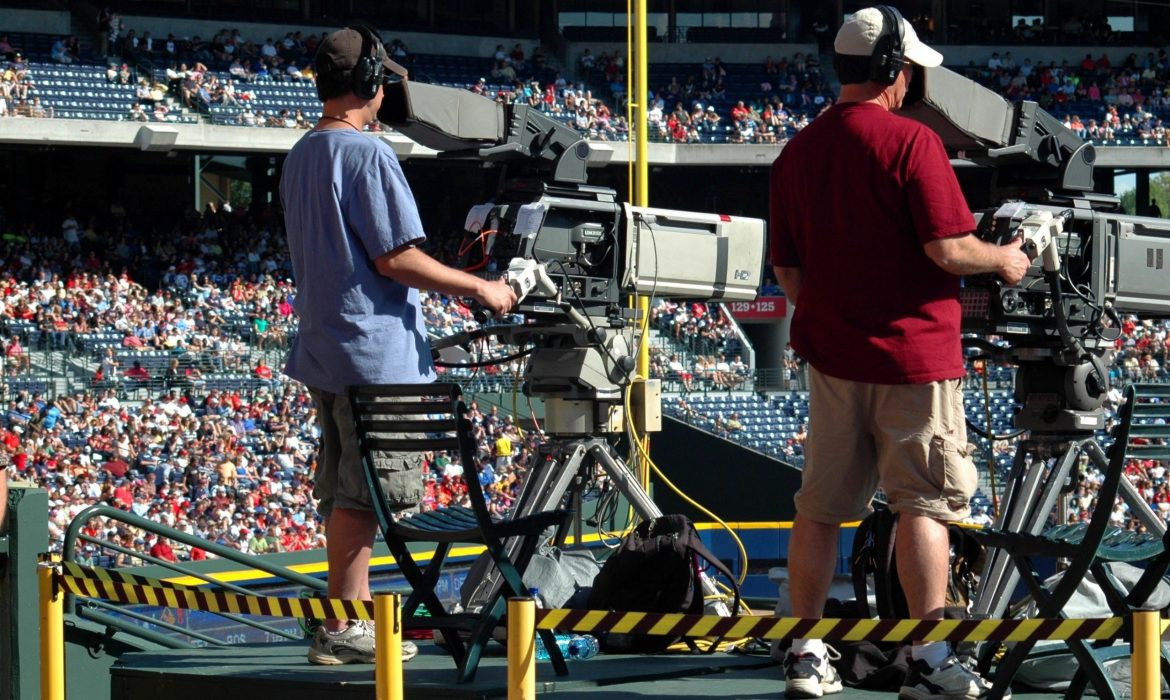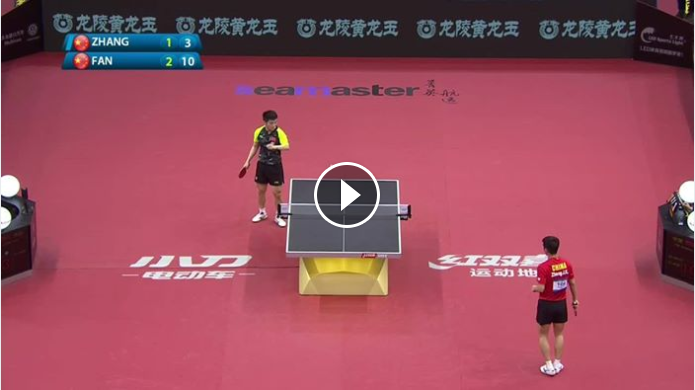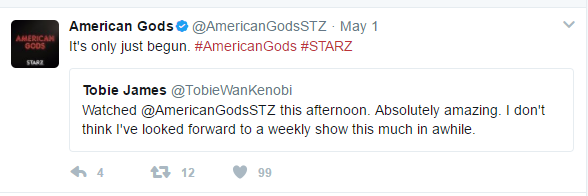Make that leap and get your live video content onto social media
One of humankind’s greatest ever achievements – landing on the moon – was widely televised. It was a giant leap for humankind. But how will we all tune in when someone first walks on Mars? Most likely live via social media and on different devices – from smartphones to tablets and VRs.
But before we go that far, let’s get back to Earth for a second, and let the numbers talk!
The rise of live video content online
By 2019 video will be responsible for 80% of global internet traffic. Live video alone will consume 13% of internet video traffic by 2021. At the same time, in the United States, TV audiences dropped by 11% between 2010 and 2016.
Most predictions suggest a continued decline in traditional TV viewing, just as new viewing habits appear to be unstoppable. Audiences increasingly look for live video content online.
But while live video on social media is already huge, it’s not even close to saturation. With millennials and generation Z at the helm, the future of live video content looks bright and promising. Here are some steps you can take to get your live video onto social media.
Create a multi-channel strategy
The very first step to jumping on the social video bandwagon is to create a multi-channel strategy for your brand, incorporating the right channels for you.
When it comes to live video, Facebook is number one among social networks. It holds 45% of the social media streaming market share. Without doubt, Facebook is going to be a major platform for social media broadcasters for a long time.
“People spend more than 3x more time watching a Facebook Live video on average compared to a video that’s no longer live”[1]
The second most popular platform for live video content is YouTube, with 44% of video market share. It is rightly a natural place for live content, so when planning your presence on social media, don’t forget to consider Google’s flagship video platform.
Other significant social media broadcasting players are Instagram and Snapchat with 28% and 19% market share respectively.
Go multi-channel for the win
The importance of social media doesn’t mean it’s time to simply ditch traditional broadcasting platforms. It’s not about moving your business to the internet entirely. Rather, it’s about implementing a multi-channel strategy as soon as possible. One that will enable you to capture and engage with the huge audiences that exist online.
What the stats tell us, is that demand is huge. This is partly due to people’s preference for watching videos over reading text online (nearly two thirds of people on the internet prefer it this way). Other sources also point out that if you consider all videos on Facebook, including live broadcasts, that these are being viewed around 64 billion times daily! That’s a staggering amount of views, right?
What these stats mean is that the internet is full of people eager to watch live video broadcasts, as far as it’s related to their passions and interests.
Keep an eye on this fast-evolving environment
Today the MVPs may well be Facebook, YouTube, Instagram and Snapchat. But tomorrow – who knows?
One thing is for sure. If you can adapt the channels you use to get live video to your audiences as they want it, then you will succeed when it comes to social media.
As you can see, the above numbers speak for themselves. So why not make that leap and get your live video onto social media today!
[1] https://newsroom.fb.com/news/2016/03/news-feed-fyi-taking-into-account-live-video-when-ranking-feed/
A recipe for video content success: Lonzo Ball and the Summer League buzz
While it’s not everyone’s favourite, partly due to being played in the silly season, this year’s NBA Summer League was truly special. Lonzo Ball was the star earning MVP status on the court, while his father courted controversy off it. The surrounding buzz led to record viewing figures – with six of ESPN’s seven most-viewed games featuring the LA Lakers draft star.
ESPN proved willing to run with the Lonzo hype and the buzz his father, LaVar, was able to build around him. The channel struck gold with the duo, and their presence helped to build a buzz around the Summer League.
Some of the factors that helped build a buzz:
- A superstar in the making
There’s no doubt, Lonzo is a superstar on the rise. He has outstanding skill and is an unusual size for his position, which makes him an interesting proposition. It didn’t hurt that he brought passion and emotion to the court in front of big crowds in the stands and on TV, making him the Summer League’s Most Valuable Player.
- Lonzo, the lead story
Matching his performances, Lonzo maintained a position as the most written-about player throughout the Summer League. Media Cloud stats tell the story – he outpaced other players with 702 mainstream news stories, more than the 2nd and 3rd players combined.
- LaVar, a slice of controversy
There’s no doubt that “a ton of the attention Lonzo receives stems from his brash, outspoken father, LaVar,” according to a fantastic article on the FiveThirtyEight website. As he tried to bolster his family’s brand value any way he could, one of LaVar’s standout comments was to claim he was a better basketball player than Michael Jordan. Tweeters used #lavarballsays to mock him (ironically adding more fuel to the selfless promotion of the Ball name).
- The media were kept guessing
With Lonzo yet to sign a shoe deal with one of the major brands, masses of media attention surrounded what sneakers he would wear. This speculation was only encouraged by the Ball family releasing their Big Baller Brand shoes. So every time Lonzo put on a different pair of sneakers, people would be asking is it another marketing ploy?
What was the recipe for ESPN’s success?
ESPN fully capitalised on the buzz surrounding the Summer League. By combining TV broadcasts with video content and social media activity, the channel was able to engage its audience and even make some good gains. For example, 2017 Google Trends data shows huge increases in searches related to ‘NBA Summer League’.
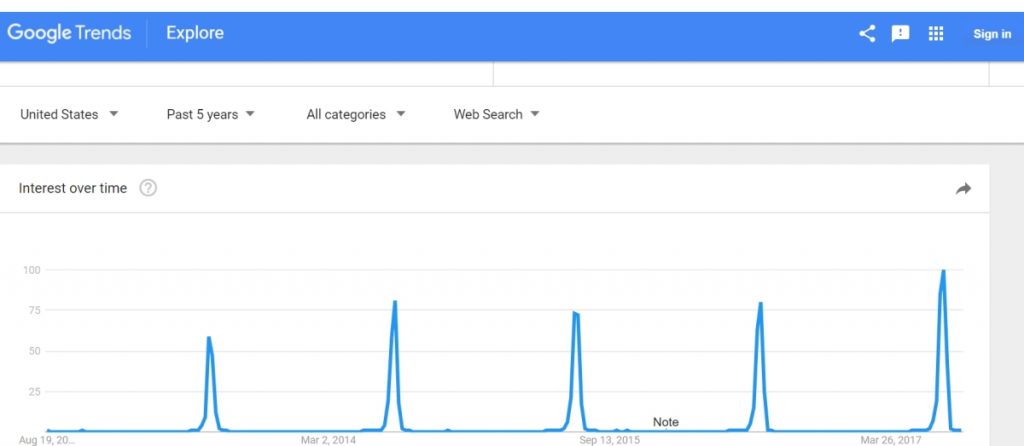
Google Trends for “NBA Summer League” term popularity
ESPN seemed to get its mix of ingredients just right.
- Great timing
The silly season is usually a bad time to break records. But the game between two great teams (Boston Celtics vs LA Lakers) and the duel between draft picks 2 and 3 (Lonzo Ball of the Lakers vs Jason Tatum of Celtics) presented opportunities for ESPN.
To hype the game, ESPN broadcasted a three-part documentary – Best of Enemies – exploring the Celtics/Lakers rivalry as part of its 30 for 30 series. The game itself was the most-watched Summer League game ever, with over 1.1million views on ESPN.
- Tons of shareable content dedicated to Lonzo Ball
Through content, ESPN were able to build a narrative thread that resonated with fans. It managed to maintain the hype surrounding the lead star, presenting Lonzo Ball as the future superstar and maybe as good as his father claims he is!
More than 1,000 articles and videos dedicated completely or partially to Lonzo or other Ball family members have also been created by ESPN.
- Big characters can add to the story
Lonzo Balls’ father, LaVar, was definitely one of the stars of the Summer League. You can dislike him, but the hype around his son is definitely his success. His opinions also get him airtime. On ESPN’s First Take Show, LaVar gets into a heated debate regarding his views on beating Michael Jordan in a game of one-on-one!
You may not have a Lonzo in your locker, or even want a LaVar on your team! But I hope you can take away some of the ingredients that created such a buzz around the Summer League and made it such a success.
Get inspired: compelling examples of sports brands using video content
When it comes to online video, audiences have developed a highly sophisticated filter. They can easily differentiate sterile marketing products from content made with real passion.
Cutting through this filter can be a challenge. How can you ensure your well-produced, professional and inspiring stories stand out? How do you make them sincere and genuine for your audiences?
There are lessons to be learned from other sports brands. Here are some examples of videos made with true passion and dedication.
Urbex by Red Bull
Red Bull is all about giving you energy to increase performance. With its Urbex videos the brand lives its promise, showcasing urban explorers performing at the edge, sometimes literally! These explorers risk life and limb doing stunts on the most extreme of man-made structures. Strictly off-limits, these forbidden structures might be a massive skyscraper in Dubai, a cosmodrome in Kazakhstan or abandoned tunnels below a big city.
While Red Bull’s content is always avant-garde, the Urbex series is some of the most epic video content ever produced. Each 40-minute episode focuses on two or three urban explorers as they scout their structures, and plan and perform mind-blowing stunts. If you suffer from a fear of heights, you might want to stay away. If not – prepare to collect your jaw from the floor!
Lesson to take away: remember the DNA of your brand, live its promise and keep it real!
ParaTough by the Canadian Paralympic Committee
Paralympic sports have until recently existed on the periphery. That’s until organisations like the Canadian Paralympic Committee (CPC) started tearing down some barriers and redrawing the boundaries.
With its ParaTough videos, the CPC challenged people to re-evaluate how they view people with disabilities taking part in sport. The videos were even able to go further, showing that not only are paralympic sports people working harder but their struggle is actually more heroic. Videos in the campaign show examples of the exercises that helped these heroes reach the Paralympic Games. Will you dare to try at least one of them?
Lesson to take away: engage users by showing them real struggle – the pain, the sweat, the sacrifice. Dare them to take part and better themselves in some way.
This Girl Can by Sport England
Sport England is a UK public body responsible for growing the number of people taking part in sports. It identified a need to empower more women to take up sporting activity and to counteract anxieties and assumptions that might make women feel they can’t get involved.
With its This Girl Can campaign, Sport England empowered women of all ages and ethnicities to do sports and take up general physical activity. Campaign video spots showed everyday women having fun in the gym, at running tracks, on football pitches, in boxing halls, or simply in their backyard! In the videos, the women all look natural, strong and inspiring, which has given the campaign immense credibility and made it a huge success.
Lesson to take away: empower your audience by showing that they can do cool and inspirational stuff.
‘Beauty and the Bull’ by Chicago Bulls
Just like combining apples and oranges – they’re pretty cool separately, but nobody thinks about mixing them together – so it was with the Chicago Bulls and musicals. There are Bulls’ fans and musical fans, but fans of these two things? Not so likely.
But when the six-time NBA title winners prepared a musical for their fans, it was a huge gesture and extremely well received. Produced using smartphones and Snapchat, ‘Beauty and the Bull’ was a three-minute story told through short-form videos – each clip lasting only a couple of seconds. It wasn’t the best, most cutting-edge production of all time, but fans were positive in their feedback. While we don’t expect to see Real Madrid making their own Snapchat version of Don Quixote, the idea was cool and executed nicely in an authentic way. You may not like it, but you can’t deny it’s a fresh and innovative idea to use.
Lesson to take away: sometimes it’s good to create something completely new, just from the bottom of your heart. Fans will appreciate it!
Feel inspired? So, what will be your next video production?
How to prep and promo live-streamed sports content
Sports fans are a highly-engaged bunch. They’ll have sports they love and an in-built passion for their teams. Of these devoted fans, 66% go online at least once a day for sports content. Nearly half prefer to follow their teams digitally, using up to five devices to consume sports.
How can you cement relationships with fans already emotionally engaged? How can you tap into fan hunger for sports content across devices? Live streaming could be the answer.
Here, I’ve created a ten-point plan to help you prep and promo live-streamed sports content
PREP
Facebook Live can be less polished and more raw and authentic, according to Hootsuite’s Amanda Wood. However, being raw and authentic is not the same as appearing unprepared. So…
Define your live stream
What do you want to achieve and how will going live help? You may want to show fans behind the scenes, or live stream entire matches. Be clear about what you want to do.
Think about presentation
If someone is going to present a live stream, think about their appearance and style of presentation. Practice beforehand. Go through your running order and agree camera angles, as well as other logistics.
Test your equipment
Test rigorously. One of the downfalls of many live streams is poor sound. Perhaps invest in some basic professional equipment to help your streams to shine.
Prepare extra live content
If you’re streaming games there will be breaks. Make sure you have content to fill these, such as glimpses from the locker room or interactions with a live audience.
Be ready to engage
Hootsuite always have an ‘engagement person’ ready to interact with and respond to comments during live streams. This is a great idea, as you can catch fans in the moment.
PROMOTE
Seventy-two percent of sports fans are most engaged by exciting pre-game content. They often second screen, frequently using laptops or smartphones to search for sports-related content during games. How you promote a live stream can tap into this…
Inform your audience
Use all marketing channels at your disposal – from email announcements to social media channels – to guide people to your broadcast. If you’re being really efficient, you might pre-schedule social updates before your event using a social media management platform.
Schedule a ‘Go Live’ notification
A Go Live notification is a great way to let people know when to tune in via Facebook Live. In your video settings, simply toggle the switch from off to on. Once done, followers can subscribe to your channel and receive a push notification when your broadcast begins.
Create sneak previews
Remember, sports fans are more engaged pre-event. Hype them and your event by releasing sneak previews. Short-form videos work well as they’re likely to be re-shared.
Keep promoting in real-time
As your event unfolds, create video highlight clips and share them through all social media channels. This will encourage people to watch the main livestream.
Re-purpose content post-live
Once you’ve gone live, repurpose and re-share the recorded event as short form videos. These can be used to promote your next live stream.
Creating and distrubuting short-form promo videos (mentioned in points 8-10) is easily achieved with our Tellyo platform.
If you’ve got any good pointers to include in the above plan, please post in the comments below.
Everything you’d like to know about video streaming, but were afraid to ask
If you are just about to start your adventure with professional live video streaming, you may well be a little bit confused. Whether you’re a social media specialist or digital marketer or you’re working in sport, fashion or the music business, streaming will undoubtedly improve your content, brand visibility and boost sales. But there’s a plethora of things you need to remember, learn and tons of options to choose from. Let’s start with the basics and answer some of the most commonly asked questions regarding live video streaming.
What are the best ways to livestream an event and why?
There are many free solutions if you want to stream an event, which you can easily check out for yourself. For personal use, the free solutions can be great. But if you aspire to professional streaming of any kind, the free options aren’t going to offer you enough.
Free software solutions for live video streaming (whether an online or desktop solution) are either not advanced enough or simply not good enough. When using a free solution it is quite common to encounter problems during a livestream and highly likely you will not be able to get support when it comes to technical issues.
If you aim to create great live streamed content and promote your event effectively, you should put in place specialist software that will enable you to better configure and manage your stream.
Professional quality never comes for free!
In answering the question, to stream your event in the best possible way, use professional tools to guarantee great results.
What is the best software for live video streaming?
Here at Tellyo, we’ve put a lot of expertise into creating our streaming software. We’re confident it is one of the best professional solutions for streaming regardless of the event type – be it a sports match, fashion show or music gig. Why?
Specifically designed for streaming and clipping videos, our software platform enables you to edit your content and its audio, and adjust videos to fit different formats and streaming destinations (such as Facebook and YouTube).
Tellyo is cloud-based software built on a core platform that delivers two separate solutions to choose from: Tellyo Pro for extensive usage when you have lots to live stream; plus Tellyo On Demand for occasional streams and when you want no strings and simple payments. Both are fully professional solutions and support the most popular social media channels like Facebook, YouTube, Twitter, and Periscope.
You can request Tellyo Pro demo here (we will require some technical details from you) or simply create your account in Tellyo On Demand and start streaming.
What are some of the best live video broadcasting sites to stream live events?
If you want to stream to social media using a channel that’s already popular in the market, there are quite a few streaming-friendly sites we can highlight:
- YouTube
- Periscope
What’s great about the above platforms is that they not only offer streaming features, but also include other cool features too, like chat (YouTube) or announcements and sponsored posts (Facebook). However, the most important part of the deal is that popular social media channels offer direct contact with audiences on pre-established platforms.
Is it possible to live stream to Facebook, YouTube and Twitter simultaneously?
Yes. You can stream to all of the above mentioned platforms simultaneously using Tellyo. Additionally, you can broadcast to other, custom RTMP destinations.
What are some KPIs for live streaming?
This will very much depend on your strategic objectives. If you wish to gain audience and brand visibility, you should aim to get as many viewers and views as possible. Total reach is also a valuable indicator because it shows how many people could have potentially viewed your content.
Depending on your needs, other indicators might include engagement signals (likes, comments and shares), leads and sales, or new signups to on-demand platforms.
It is crucial to set some goals before you start a stream, as these will give you something to measure against.
What are the best practices for live streaming events?
We’ve prepared a number of articles that you might find useful, regardless of your streaming experience or industry knowledge:
- Improve your social broadcasts with different content types
- 8 common live streaming mistakes
- What indicates success? The social video KPIs that count
- Going social with your broadcast: the basics
- Sports video content ideas to help you survive out of season
- How to prepare and promo live-streamed sports content?
- How to incorporate sponsorship into your real-time social videos
- How to turn broadcast content into great social live streams
- Three ways to maximise real-time interactions with fans
- Understanding the power of online sports videos
- A sport marketer’s simple guide to Facebook post promotion
Explore our blog for other interesting insights and ideas.
Is it possible to clip videos out of a live stream?
Using Tellyo – yes. Our platform allows you to cut clips out of live streams and simultaneously share them on social media in a matter of seconds. You can enhance your clips using our feature-packed Editor or simply clip-and-publish. Videos can be distributed straight from the Editor to the most popular social platforms of your choice. If video editing and live streaming is your main concern – consider using Tellyo.
What kind of events can be turned into live video streams?
There’s really no correct answer to this. However, if you’re responsible for an event and it would benefit from having a larger audience, or you want to reach people who are unable to attend in person, then it would be a good option to stream.
To understand what kind of events others are streaming, let’s take a look at some of our clients:
Our Tellyo Pro is used mainly by sports leagues and federations, and TV and digital broadcasters. They will own content or have the rights to stream it, so they require a trusted service that will enable them to broadcast their content directly to social media. They stream big amounts of content regularly, such as entire matches and complete shows.
Tellyo On Demand is used across sport, fashion, music and event organising. It offers a more flexible option and is suitable for organisations who only need to stream from time to time, but still want to rely on an excellent service. They stream small amounts of content, such as occasional behind-the-scenes footage, gigs, press conferences, and fashion shows.
Still not convinced?
If you still have some doubts regarding live video streaming, live production, real time video sharing or anything in between – let us know. Send in your question(s) using our form, message us at contact@tellyo.com, or make contact via social media.
A three-point plan for broadcasters sharing content during live events
Social media marketing that’s ‘in the moment’ has huge potential and value for broadcasters.
Through social channels, your viewers can be made to feel as if they’re in the moment. They can experience something as if they are there in person, rather than watching a recording.
You have two options: you can use live streaming, or create and share content in real-time.
1. Choose your channel wisely
First up, choosing the best channel is vitally important. Think about what you want to achieve and look for your audience. Also, consider how easy it will be to manage each channel for your event. Here’s a quick rundown of your main options:
Facebook Live
The king of live streams, Facebook Live has the potential to pull in huge audiences. Its users spend three times longer watching live video (than video that’s not live).
Facebook’s live streaming is easy to use and share. When BuzzFeed decided to explode a watermelon one rubber band at a time, little did they know it would be one of Facebook Live’s biggest hits. Over 800,000 people tuned in during the broadcast’s peak. It has since amassed more than 11 million views.
If you’re planning to share in real-time (as opposed to immediately live), Facebook is also a perfect place for short-form videos. Clips and highlights work well.
The International Table Tennis Federation use its live streams and our platform to create and drive short-form videos out to social media. In the process, they engage with and pull in fans.
Twitter is all about moments. The platform is fast becoming the place to watch live events and experience real-time action. It wants to be “the first place where people hear of what matters”, says its CEO Jack Dorsey.
From sports to news to entertainment programming, it has streamed more than 800 hours of live content in Q1 2017, reaching 45 million viewers. But it’s not just for big brands. Twitter live streaming is open to everyone.
But where Twitter slams it… real-time sharing…
John Wall, are you for real?! #SCtop10 pic.twitter.com/p8eP75r0Wo
— SportsCenter (@SportsCenter) May 8, 2017
YouTube
YouTube is a great place to live stream content. It is utilised by news channels, TV shows and even streams live from the International Space Station.
2. Prep, prep, prep
No matter what channel you choose, put in lots of prep before your live event. The first thing to do here is…
Have your graphics ready
For example, in the French Ice Hockey League the Rouen Dragons have created a bumper at the beginning of each clip. It shows both the Fanseat and sponsor’s logo. The graphic has been pre-prepared for each clip and is inserted using our Tellyo platform.
Be active during breaks
Create short highlight clips in real-time and share these during breaks, such as at half time. This will whet your fans’ appetite for more.
.@KingJames & @kevinlove combine for 36 points in the first half to lead the @cavs! #NBAPlayoffs pic.twitter.com/NtKov04sey
— NBA on TNT (@NBAonTNT) May 18, 2017
If not video, plan photos you can share during the build-up to an event or as things are happening.
Lookout for extras
If you’re multicasting, you will create a lot of footage that might never get used. Have someone in your social media or marketing team on the lookout for funny moments or behind-the-scenes footage. Turn these into social videos.
Here’s a great example of a funny clip, which is the kind of thing you might also choose to share:
Mascot took his shirt off for JR LMFAOO pic.twitter.com/4pIDQKrpRZ
— Scottie Pimppen (@BullsLegacy) May 11, 2017
If not video, plan photos you can share during the build-up to an event or as things are happening.
3. Learn from other industries
Always be on the lookout for inspirational examples of live streaming and real-time sharing.
The first here is a classic from Oreo, seizing on the black-out during 2013’s Super Bowl final:
Power out? No problem. pic.twitter.com/dnQ7pOgC
— Oreo Cookie (@Oreo) February 4, 2013
Dunkin Donuts hilariously joined the viral blue/black or white/gold dress debate with this tweet:
Doesn’t matter if it’s blue/black or white/gold, they still taste delicious. #thedress pic.twitter.com/Oq8srrAKnd
— Dunkin’ Donuts (@DunkinDonuts) February 27, 2015
And when Luis Suarez bit Giorgio Chiellini during 2014’s World Cup, Snickers were quick to respond:
Hey @luis16suarez. Next time you’re hungry just grab a Snickers. #worldcup #luissuarez #EatASNICKERS pic.twitter.com/3RAO537HjW
— SNICKERS® (@SNICKERS) June 24, 2014
Three ways to maximise real-time interactions with fans
Fans are never more primed to interact with your brand than when they’re in the moment.
Whether they’re at a sports event, watching a TV show, or experiencing your brand online, fans are a mighty resource to tap into. They possess the power to make real-time interactions more impactful.
When cool things happen, share ASAP!
When it comes to live sharing, like cool passes, dribbles or dunks, the NBA slams it on social media. But such moments are not the only ones that motivate real-time interaction.
What about before your event even starts? During times when your cameras are recording footage that doesn’t make it to the screen? If you have a person with a good eye in your marketing team, let them watch the live stream and capture moments worth sharing.
NBA TV does just this. When the station shared a clip of Draymond Green simply saying ‘hi’ to NBA commissioner Adam Silver, it was a genuine moment showing the human side to sport. Fans loved it. The tweet achieved more real-time interactions than any other tweet during the game, catching people killing time before kickoff and highly engaged pre-game.
Draymond Green showing some love to #NBA commissioner Adam Silver before Game 3 vs. Utah. #NBAPlayoffs pic.twitter.com/LKYC6FwgP4
— NBA TV (@NBATV) 6 maja 2017
Use content not used on TV
On social media, your fans want to see scenes they wouldn’t get on TV.
A great example is the NBA’s KissCam. You know how it works – if you see yourself on the stadium’s big screen you kiss the person next to you. This is usually your partner. Usually….
Awkward Kiss Cam Moment Number 324… pic.twitter.com/bA52qa5ndq
— Milwaukee Bucks (@Bucks) 28 kwietnia 2017
The above tweet from Milwaukee Bucks achieved the most engagements in the club’s history, amassing nearly 3,000 retweets and 6,000 likes. On a good day, the Bucks get hundreds not thousands.
What the KissCam clip emphasises is that fans love genuine moments, particularly ones that make them laugh. Share these moments as they happen, and re-use for TV later.
Interact with your fans
Publishing sharable content in the moment can massively increase your chances of fan engagement. How you then interact via your social media profiles is a key way to forming stronger bonds with your fans. As you respond and interact, other fans will also look to join in on conversations as they happen.
Replying to comments on Facebook, or to tweets from viewers, is a great way of interacting with fans. This sort of activity can also be used to communicate your brand’s personality, presenting it in a way that fans can relate to. (Having a relatable brand is something I talked about in my previous blog.)
The STARZ team responsible for recently premiered TV show, American Gods, do a great job interacting in real-time with the show’s fans. The team’s insatiable retweeting during the season premiere was impressive, while their Facebook comments are in character with show itself. Check out the examples below:
Meet the millennials – decoding their behaviour and why they share
Millennials – generation Y, the internet generation – are now the largest generation in history.
This generational cohort (of young adults aged 16-34) are true digital natives. They are the first generation in history to have grown up immersed in digital technology. This technology is fundamental to how they see the world and communicate.
In a University of Southern California infographic on marketing to millennials, the largest millennial sub-group is shown as ‘digital socialites’. Technology is integral to this group’s very being – they’re highly social and engaged online.
Elsewhere, 2016’s Youth Trends Report highlights that fifty-two per cent of millennials describe themselves as a ‘global citizens’, seeing themselves as taking part in genuine global interactions. As millennial blogger Tanya Korobka says in the report:
“The internet has led the way to a more equal playing field… Everyone on the net is a producer and a participant of the culture at the same time. Online we are not judges by our class, race or sexuality, but solely by the information we choose to share.”
The challenge for marketers
Even the above short snippet about millennials demonstrates the impact this generation is having on marketing. Many marketers admit to finding it difficult to keep up. As marketers, we are forced to continually decode the behaviour of millennials and challenged to rethink what we already know.
How can we get into the millennial worldview (something that’s been shaped by their unique upbringing)? How should we market with them (seeing them as both producer and participant) rather than simply to them? What’s the best way to engage these highly social socialites?
The opportunities for brands
For brands, there’s good news, writes Padraig O’Connor. His top three tips for marketing to millennials starts with how millennials express themselves through brands and “want brands to have much more than just a logo. They want brands to have a personality that they like and can relate to.”
In an AdWeek article, AwesomenessTV’s James Deutch emphasises how his team focuses on ‘quality and thoughtfulness’ when making branded content that resonates with millennials.
The result was Royal Crush, a scripted romantic comedy that features stars and storylines that younger millennials can connect with. The show has achieved almost 27 million video views for six episodes.
Video is integral to millennials’ online experience
The success of a series such as Royal Crush only emphasises the importance of video to millennials. And digital marketers have been quick to grasp its significance.
Realising that powerful visual experiences are critical, GoPro kills the game with its Instagram strategy. The brand uses its feed to share videos that celebrate a lifestyle of adventure. Something that has obviously resonated with Instagram’s core millennial base, attracting 12 million followers along the way, and thousands of views and likes per post.
Experiential marketing x social media
When not watching someone else’s adventures, millennials want experiences that they can share on social media. And, having realised that millennials would rather tell people about something they’ve done than about something they’ve got, big brands are putting budget behind experiential marketing.
Experiential marketing can provide opportunities for millennials to interact with brands in person, so forming stronger emotional connections between them and a brand. Crucially it offers an experience that they can actively share, placing them at the heart of the marketing itself as both an active producer and participant.
Here are some examples:
Beer brand Asahi created a photo booth that people could step into and where fun moments were captured in slow motion on film. The booth then sent these videos to users so they could instantly share them on social media with #AsahiSlowMo. Made in Chelsea TV star Josh Patterson was invited to the launch, and his experience was seen or liked 60,000 times on his Instagram channel alone.
For Belgium TV station TNT – whose tagline was ‘We know drama’ – experiential meant setting up a big red button in a quiet town square. People could press to ‘add drama’ to their day. Videos of the dramatic scenes were witnessed live but also experienced online, achieving 55 million views on YouTube.
blinkbox Reveal Giant Dragon’s Skull on Dorset’s Coast by Taylor Herring #gameofthrones pic.twitter.com/s6VSEXgaFG
— John Evans (@Distinctboxes) August 24, 2016
To promote Game of Thrones, TV streaming service Blinkbox placed a gigantic dragon skull on a UK beach. At the time and at various exhibition shows since, the skull has formed the backdrop to many shared selfies.


